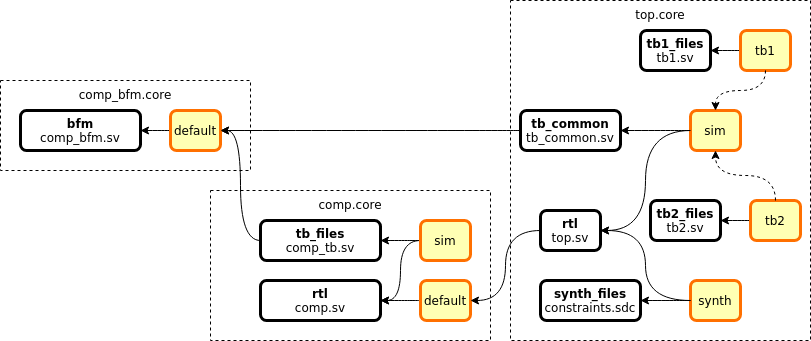Common Problems and Solutions
Making changes to cores in a library
A common situation is that a user wants to use their own copy of a core, instead of the one provided by a library, for example to fix a bug or add new functionality. The following steps can be used to achieve this:
Example. Replace a core in a library with a user-specified version
Create a new directory to keep the user-copies of the cores (this directory will be referred to as
$corelibfrom now on)Download the core source (the repository or URL can be found in the
[provider]section of the original core)If the downloaded core already contains a .core file, this step is ignored Copy the original .core file to the root of the downloaded core. Edit the file and remove the
[provider]section. (This will stop FuseSoC from downloading the core and use files from the directory containing the .core file instead)Add
$corelibto the end of your library search path, either by editingfusesoc.confor by adding--cores-root=$corelibto the command-line argumentsVerify that the new core is found by running fusesoc core-info $core. Check the output to see that “Core root:” is set to the directory where the core was downloaded
Dependency tree for a core with optional components
Many cores have a part that is only used in some flows. This could for example be a BFM, VIP or some kind of behavioral model that is only used in simulation flows. Or it could be timing constraints for synthesis. As long as these are only by the core itself, it’s easiest to put them into different filesets and let each simulation or synthesis target pick the right subset of filesets.
A more complicated situation arises when a user uses this core as a dependency and wants to have different filesets for different flows in the toplevel core. In this case, it is typically better to split out the optional part into its own cores and have the toplevel filesets depend on the different cores.
Example Let’s assume a core (comp) comes with a BFM. We want to use the BFM when doing block-level simulations of the core and when doing full system simulations which uses this core. We don’t want to have the BFM present when doing full system synthesis. The most general solution is to split out the BFM to a separate core file. The following example shows a setup with a component (comp.core) that has a BFM (comp_bfm.core) which is used inside a larger system (top.core). The component has a testbench target (sim) and the larger system has two testbenches (tb1 and tb2) which both uses the BFM and the component. The larger system can also be synthesized without the BFM.

CAPI=2:
name : ::comp_bfm:0
filesets:
bfm:
files: {comp_bfm.sv : {file_type : systemVerilogSource}}
targets:
default:
filesets : [bfm]
CAPI=2:
name : ::comp:0
filesets:
rtl:
files: {comp.sv : {file_type : systemVerilogSource}}
tb_files:
files: {comp_tb.sv : {file_type : systemVerilogSource}}
depend: [comp_bfm]
targets:
default:
filesets : [rtl]
sim:
filesets : [rtl, tb_files]
CAPI=2:
name : ::top:0
filesets:
rtl:
files: {top.sv : {file_type : systemVerilogSource}}
depend: [comp]
tb_common:
files: {tb_common.sv : {file_type : systemVerilogSource}}
depend: [comp_bfm]
tb1_files:
files: {tb1.sv : {file_type : systemVerilogSource}}
tb2_files:
files: {tb1.sv : {file_type : systemVerilogSource}}
synth_files:
files: {constraints.sdc : {file_type : SDC}}
targets:
sim: &sim
filesets : [rtl, tb_files]
tb1:
<<: *sim
filesets_append : [tb1_files]
tb2:
<<: *sim
filesets_append : [tb2_files]
synth:
filesets : [rtl, synth_files]
An alternative solution to the above, is to use flags, as described in Flags: constraints in dependencies, where the inclusion of the optional files are controlled by flags. These flags can be assigned default values in the top level targets for convenience.